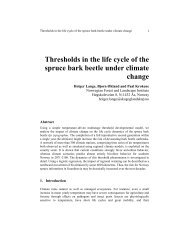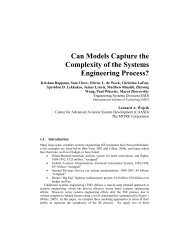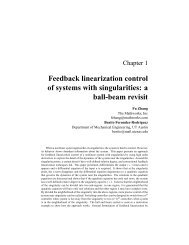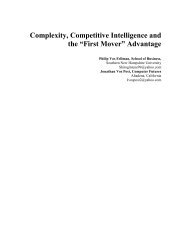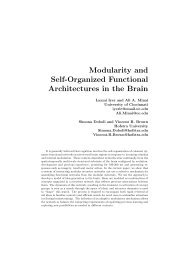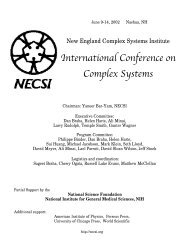the Future Map Methodology - New England Complex Systems ...
the Future Map Methodology - New England Complex Systems ...
the Future Map Methodology - New England Complex Systems ...
Create successful ePaper yourself
Turn your PDF publications into a flip-book with our unique Google optimized e-Paper software.
Improving Decision Making<br />
in <strong>the</strong> Area of National and<br />
International Security<strong>the</strong><br />
<strong>Future</strong> <strong>Map</strong> <strong>Methodology</strong><br />
1. Summary<br />
Don Heathfield<br />
The <strong>Future</strong> <strong>Map</strong><br />
dh@<strong>the</strong>futuremap.com<br />
The qualitative shift in <strong>the</strong> complexity of <strong>the</strong> global security environment requires a<br />
proactive, networked decision culture. This article proposes improving decision making<br />
in <strong>the</strong> area of national and international security by building a comprehensive, shared<br />
map of <strong>the</strong> organization’s future environment. The <strong>Future</strong> <strong>Map</strong> methodology creates a<br />
platform for leveraging numerous internal and external contributors, driving a “strategic<br />
conversation” across <strong>the</strong> organization, and linking strategy, intelligence and learning.<br />
2. Introduction<br />
The capacity of organizations working in <strong>the</strong> national and international security area to<br />
make good decisions depends to a large degree on <strong>the</strong>ir ability to anticipate <strong>the</strong> behavior<br />
of complex social and political systems. Our far from perfect knowledge of <strong>the</strong>se<br />
systems, <strong>the</strong> uncertainty and ambiguity associated with <strong>the</strong>ir future development, toge<strong>the</strong>r<br />
with often conflicting perspectives of multiple stakeholders fur<strong>the</strong>r complicate this work.<br />
To be successful in dealing with global security challenges, a proactive, anticipative<br />
approach, or what Research Professor of International Affairs at George Washington<br />
University Leon Fuerth calls “forward engagement,” is critical. Such engagement is<br />
difficult to imagine without <strong>the</strong> organization’s commitment to a “future preparedness”<br />
that involves continuous systematic exploration of its future environment, and building of<br />
capacities to meet coming challenges. From a strategic perspective, it may be more<br />
important whe<strong>the</strong>r organizations have processes and tools for continuously improving <strong>the</strong><br />
knowledge of <strong>the</strong>ir complex environment, than how well <strong>the</strong>y are able to understand this<br />
environment today. The lack of a systematic, organization-wide approach to “future<br />
preparedness” is one of <strong>the</strong> greatest hurdles that prevent organizations from adopting a<br />
more proactive strategic posture.<br />
3. Challenges of decision making in a complex environment<br />
The challenges of decision-making in <strong>the</strong> international security area arise from <strong>the</strong><br />
complex nature of social and political systems as well as from <strong>the</strong> internal complexity of<br />
organizations in charge of security. A global security environment is constantly changing,<br />
and <strong>the</strong> relations between <strong>the</strong> factors of change are often difficult to understand and<br />
quantify. The “human” factor introduces additional elements of surprise. While many
2<br />
decisions carry potentially high political and economic costs, <strong>the</strong>y have to be made fast<br />
and on <strong>the</strong> basis of information that is often ambiguous and rarely complete.<br />
At <strong>the</strong> same time, decision makers need to reconcile multiple, frequently conflicting<br />
internal perspectives. They have to consider options and strategies derived from<br />
organizational processes that are based on different methodologies and information.<br />
Short-term operational requirements may not be entirely consistent with long-term<br />
strategic goals. Personal agendas, experiences and value judgments play an important<br />
role, while distance, cultural backgrounds and organizational procedures create potential<br />
for “blind spots.”<br />
The characteristics of <strong>the</strong> international security environment define <strong>the</strong> need for <strong>the</strong> tools<br />
that have <strong>the</strong> potential to offer <strong>the</strong> most value for decision makers in managing<br />
uncertainties and risks [Van der Steen, 2005.] If we draw a chart that plots <strong>the</strong> degree of<br />
our understanding and predictability of <strong>the</strong> future environment against <strong>the</strong> rate of change<br />
impacting <strong>the</strong> organization, <strong>the</strong> following three situations are possible (Figure 1.)<br />
Low<br />
Random<br />
Understanding<br />
and<br />
Predictability<br />
<strong>Complex</strong><br />
High<br />
Simple<br />
Gradual<br />
Rate of Change<br />
Figure 1.<br />
Rapid<br />
Sudden changes, which we cannot predict may be considered random, as <strong>the</strong>y cannot be<br />
anticipated. Major accidents, natural disasters or terrorist acts can be placed in this<br />
category. To prepare for such situations, decision makers should focus <strong>the</strong>ir attention on<br />
developing <strong>the</strong> capacity of <strong>the</strong>ir organizations to withstand <strong>the</strong> impact of <strong>the</strong>se events as<br />
well as <strong>the</strong> capacity to mitigate and recover. Building organizational resilience is <strong>the</strong> only<br />
strategy.<br />
Predictable and gradual changes present a relatively simple challenge that organizations<br />
can handle using traditional strategic planning approaches. The development of robust<br />
models of <strong>the</strong> environment will go a long way towards improving <strong>the</strong> quality of strategic<br />
decisions. The evolution of <strong>the</strong> biggest “threat presented by <strong>the</strong> conventional and nuclear<br />
forces of <strong>the</strong> USSR” during <strong>the</strong> Cold War, as Leon Fuerth points out, was fairly gradual
3<br />
and predictable. As a result, <strong>the</strong> national security agenda was “prioritized around it into a<br />
hierarchy” and its management was based on “a pyramidal approach” [Fuerth, 2006.]<br />
The space between <strong>the</strong> simple and random is by definition a domain of complexity<br />
[Wikipedia.] The growing complexity of today’s security environment manifests itself in<br />
two ways. Not only do we have to deal simultaneously with multiple, often inter-related,<br />
yet distinct challenges, but <strong>the</strong> underlining economic and political changes are driven not<br />
only by governments, but increasingly by “multinational corporations, state-owned<br />
enterprises, non-government organizations (NGOs), and even by “super-empowered<br />
individuals” [Bremmer, 2006.]<br />
Dealing with relatively well understood but rapid changes, <strong>the</strong> aftermath of a financial<br />
crisis, for example, requires strong implementation and coordination capabilities, while<br />
relatively slow but ambiguous developments, such as strategic implications of new<br />
technologies or climate change, will challenge <strong>the</strong> organization’s capacity to anticipate<br />
and adapt.<br />
According to Fuerth, “we have entered <strong>the</strong> period when <strong>the</strong> problems we face are<br />
<strong>the</strong>mselves networked: Information about <strong>the</strong>m is marked by complex interaction, and<br />
organization for dealing with <strong>the</strong>m must become flattened and integrated. The expertise<br />
required to track <strong>the</strong>se problems has broadened.”[Fuerth, 2006.] To achieve success, <strong>the</strong><br />
complexity of <strong>the</strong> organization’s decision-making system must be, using <strong>the</strong> words of<br />
Yaneer Bar-Yam, “correctly matched to its environment” [Bar-Yam, 2004.]<br />
In this complex environment <strong>the</strong> ability of organizations to shorten <strong>the</strong> time between <strong>the</strong><br />
recognition of warning signals and <strong>the</strong> implementation of decisions is critical. Success<br />
depends on how fast <strong>the</strong> whole organization can see <strong>the</strong> “big picture” and learn to change<br />
its ways of working. Organizations need a rigorous “future preparedness” process that<br />
would drive <strong>the</strong>ir collective learning about <strong>the</strong> behavior of <strong>the</strong> complex systems around<br />
<strong>the</strong>m. In practice, <strong>the</strong>y should focus on <strong>the</strong> following strategies:<br />
• Develop, in absence of reliable environmental models, <strong>the</strong> ability to learn<br />
about <strong>the</strong> behavior of <strong>the</strong> “target” systems using a “forced learning” method<br />
based on trial and error: proactively anticipate changes, comparing as many<br />
perspectives as possible, while being ready to question <strong>the</strong>ir assumptions<br />
and adjust <strong>the</strong> picture of <strong>the</strong>ir future environment as changes occur.<br />
• Improve <strong>the</strong>ir capacity to meet unanticipated challenges faster and more<br />
effectively: quickly share <strong>the</strong> “big picture” of changes and challenges across<br />
<strong>the</strong> organization, accelerate adaptive learning processes, mobilize<br />
commitment, drive and measure <strong>the</strong>ir progress towards <strong>the</strong> new objectives.<br />
Both strategies require <strong>the</strong> creation of <strong>the</strong> “working picture” of <strong>the</strong> future that can be<br />
shared, debated, and contributed to by many actors across <strong>the</strong> organization, as well as <strong>the</strong><br />
dynamic scorecard of <strong>the</strong> organization’s performance in relation to its future challenges.<br />
4. Requirements for <strong>the</strong> Picture of <strong>the</strong> <strong>Future</strong> Environment<br />
To improve decision-making we have to create and organize a shared future space. The<br />
picture of <strong>the</strong> future environment needs to be based on a common denominator that does<br />
not depend on <strong>the</strong> type of methodology employed and <strong>the</strong> source and nature of <strong>the</strong><br />
information. This picture must be able to display both strategic and operational future in<br />
real time. The process of building this shared picture must fulfill <strong>the</strong> following<br />
fundamental requirements:
4<br />
1. Create a boundary-less, systemic, holistic view of <strong>the</strong> future security<br />
environment based on broad inter-domain, inter-agency, and when possible,<br />
global expertise.<br />
2. Bridge <strong>the</strong> methodological gap between future-related techniques and processes<br />
and established “core” organizational tools and processes, thus making future<br />
preparedness a daily activity linked to established reporting and measurement<br />
tools such as organizational scorecards. [Kaplan and Norton, 1996.]<br />
Organizations need to track not only <strong>the</strong> external environment, but also <strong>the</strong>ir<br />
internal preparedness progress.<br />
3. Connect four elements – future exploration, early warning, communication, and<br />
use of information about <strong>the</strong> future as parts of one comprehensive system, a<br />
unique depository of all future-related knowledge, as well as a real-time, shared<br />
space for exchanges, analyses, debates and learning.<br />
4. Integrate both long- and short-term preparedness perspectives – be reactive<br />
enough to offer real time intelligence along with strategic foresight, to avoid <strong>the</strong><br />
competition for decision makers attention between <strong>the</strong>ir daily needs and <strong>the</strong> “big<br />
picture,” recognizing that both are essential to strategic success.<br />
5. Ensure a highly intuitive visual interface, in order to be able to communicate <strong>the</strong><br />
situation and key messages quickly, and speak <strong>the</strong> language of decision makers<br />
in a way that conveys highly strategic analysis along with pure facts.<br />
Where can we look for inspiration in designing such a tool? Take <strong>the</strong> example of <strong>the</strong><br />
Airborne Warning and Control System (AWACS). What makes it so valuable?<br />
Integrating on one screen and tracking in real time <strong>the</strong> battlefield and <strong>the</strong> movements of<br />
own and hostile forces, <strong>the</strong> AWACS creates a transparent decision environment, in which<br />
both staff and field participants can contribute and learn. As <strong>the</strong> result, <strong>the</strong> AWACS<br />
allows to conduct joint, network-centric warfare, linking “sensors, decision makers and<br />
shooters to achieve shared awareness,” [Alberts, quoted from Fuerth, 2006.]<br />
We need tools that create “shared awareness” of <strong>the</strong> complex and continuously changing<br />
global political and security environment and that extend this awareness “as far into <strong>the</strong><br />
future as possible” [Fuerth, 2005.] Without such tools it is hardly possible for <strong>the</strong> new<br />
decision making culture to take hold.<br />
5. The Event Field<br />
How can we assemble a shared picture of <strong>the</strong> future from a multitude of facts and<br />
opinions? How can we present <strong>the</strong> future in a way that facilitates decision-making? How<br />
can we get <strong>the</strong> maximum number of people within and outside of <strong>the</strong> organization<br />
involved into <strong>the</strong> scanning of <strong>the</strong> global environment? How can we learn to continuously<br />
question our assumptions and conclusions? How can we make <strong>the</strong> information collection<br />
and information assessment processes work toge<strong>the</strong>r as one?<br />
All future scenarios, objectives, decisions, and warning signals are <strong>the</strong> events that we<br />
anticipate. Using an anticipated event as <strong>the</strong> “common denominator,” we can recreate our<br />
future environment, both short- and long-term. We believe that we need to put in front of<br />
decision makers <strong>the</strong> field of anticipated events with which <strong>the</strong> organization will have to<br />
deal in <strong>the</strong> future. This Event Field is <strong>the</strong> product of our collective anticipation; it is <strong>the</strong><br />
picture that appears on our collective future “radar screen.” Our goal is to construct <strong>the</strong><br />
organization’s Event Field and <strong>the</strong>n continuously question and clarify this picture of <strong>the</strong><br />
future using all means available.
5<br />
The purpose of <strong>the</strong> Event Field is to involve decision makers in a collective learning<br />
process that focuses <strong>the</strong>m on future preparedness. By introducing <strong>the</strong> future Event Field,<br />
we are shifting <strong>the</strong> discussion, as Arie de Geus proposed, from “whe<strong>the</strong>r something will<br />
happen” to “what would we do, if it happened.” [Arie de Geus, 1999.] The process of <strong>the</strong><br />
construction and assessment of <strong>the</strong> organization’s future Event Field forces <strong>the</strong><br />
participants to “live in <strong>the</strong> future,” going back and forth in time, “trying on” various<br />
alternatives. It takes decision makers from “future awareness” to ”future appropriation.”<br />
This process is consistent with <strong>the</strong> observations about how people unconsciously prepare<br />
for <strong>the</strong> future made by <strong>the</strong> Swedish neurobiologist David Ingvar and described in his<br />
article “The memory of <strong>the</strong> future” published in 1985. According to Ingvar, a part of <strong>the</strong><br />
human brain “is constantly occupied with making up action plans and programs for <strong>the</strong><br />
future,” making “alternative time paths into <strong>the</strong> future,” and “storing <strong>the</strong>se alternative<br />
time paths.” This “memory of <strong>the</strong> future” helps us to establish a “correspondence<br />
between incoming information and one of <strong>the</strong> stored alternative time paths,” thus<br />
perceiving its “meaning.” It also allows us to filter out irrelevant information that has no<br />
meaning for any of <strong>the</strong> “options for <strong>the</strong> future which we worked out” [quoted from Arie<br />
de Geus, 1999.] By creating a similar process in organizations, we can help <strong>the</strong>ir leaders<br />
visualize strategic paths towards <strong>the</strong> future, identify and prioritize <strong>the</strong> critical changes in<br />
<strong>the</strong>ir security environment, and develop and effectively execute strategies.<br />
6. Construction of <strong>the</strong> <strong>Future</strong> <strong>Map</strong><br />
A field of anticipated events can be built for any domain or entity, whe<strong>the</strong>r an<br />
organization or a country. Following <strong>the</strong> practice of social scientists, we define an<br />
anticipated event as Who will do What to Whom/with Whom, When and Why.<br />
The Event Field stretches as far into <strong>the</strong> future as available information allows. In <strong>the</strong><br />
Event Field, anticipated events are arranged on a timeline, in <strong>the</strong> columns that correspond<br />
to <strong>the</strong> key factors that impact <strong>the</strong> future of <strong>the</strong> organization (Figure 2.)<br />
Event Field Structure<br />
Event<br />
Event<br />
Event<br />
More<br />
Factors<br />
Event<br />
Event<br />
Event<br />
Event<br />
Event<br />
Event<br />
Event<br />
Event<br />
Event<br />
<strong>Future</strong><br />
Today<br />
Past<br />
Event<br />
Event<br />
Event<br />
Event<br />
Event<br />
Event<br />
Event<br />
Event<br />
Event<br />
Event<br />
More<br />
Factors<br />
Factor<br />
3<br />
Factor<br />
2<br />
Factor<br />
1<br />
Factor<br />
1<br />
Factor<br />
2<br />
Factor<br />
3<br />
Internal Factors<br />
Figure 2.<br />
External Factors
6<br />
Factors that influence <strong>the</strong> future may represent <strong>the</strong> external environment as well as <strong>the</strong><br />
internal situation of <strong>the</strong> organization. These factors can be divided into several levels of<br />
sub-factors, and fur<strong>the</strong>r into scenarios of <strong>the</strong>ir likely development. (Figure 3.)<br />
Figure 3.<br />
The Event Field integrates into <strong>the</strong> two-dimensional “Time-Factors” framework<br />
information from all contributors inside and outside <strong>the</strong> organization: early warning<br />
networks, external expert communities, newswire reports, trend forecasts or automatic<br />
extraction tools. Internal decisions can also be incorporated into <strong>the</strong> Event Field as<br />
anticipated events. The Event Field creates a space into which <strong>the</strong> information from all<br />
sources can be continuously fed. While working with a multitude of continuously<br />
evolving events related to a large number of factors may seem exceedingly challenging,<br />
specialized web-based software solves this problem (Figure 4.)<br />
Figure 4.
7<br />
From a methodological point of view <strong>the</strong> development of <strong>the</strong> Event Field is consistent<br />
with <strong>the</strong> principles of morphological analysis, a “method for rigorously structuring and<br />
investigating <strong>the</strong> total set of relationships in inherently non-quantifiable socio-technical<br />
problem complexes,” introduced in its modern form by Fritz Zwicky and fur<strong>the</strong>r<br />
advanced by Tom Ritchey and o<strong>the</strong>rs. [Ritchey, 2005.] We believe that many<br />
methodologies and software developed to support Morphological Analysis can be applied<br />
to <strong>the</strong> strategic analysis of <strong>the</strong> Event Field.<br />
The Event Field methodology (patent pending) establishes <strong>the</strong> step-by-step continuous<br />
circular process of constructing <strong>the</strong> Event Field in <strong>the</strong> domain and <strong>the</strong>n assessing this<br />
Event Field to extract useful knowledge for decision-makers. This methodology defines<br />
<strong>the</strong> framework for identifying and assessing risks, impacts and probabilities associated<br />
with anticipated events. It offers a structured approach to <strong>the</strong> collection of information<br />
about <strong>the</strong> driving forces in <strong>the</strong> domain, and establishes <strong>the</strong> process of continuous<br />
reassessment of <strong>the</strong> Event Field to factor in <strong>the</strong> latest knowledge.<br />
Scenario technique plays a key role in <strong>the</strong> construction of <strong>the</strong> Event Field, helping to<br />
outline alternatives in <strong>the</strong> development of each factor and to imagine various<br />
combinations of outcomes of multiple factors that constitute different future<br />
environments. To ensure consistency, <strong>the</strong> Event Field is built from two opposite<br />
directions at <strong>the</strong> same time: from <strong>the</strong> long-term scenarios towards <strong>the</strong> present by tracking<br />
scenario milestones, and from <strong>the</strong> present towards <strong>the</strong> future by converting observed<br />
trends into anticipated events. As <strong>the</strong> forecasts made using different independent<br />
methodologies are translated into events, we can crosscheck and refine our assumptions<br />
and expectations.<br />
Once <strong>the</strong> future Event Field for <strong>the</strong> organization or a domain has been created, we can<br />
extract from it a number of <strong>Future</strong> <strong>Map</strong>s. These <strong>Future</strong> <strong>Map</strong>s are <strong>the</strong> “snapshots” of <strong>the</strong><br />
Event Field that represent <strong>the</strong> future seen through <strong>the</strong> lens of different perspectives. Each<br />
<strong>Future</strong> <strong>Map</strong> can convey a particular scenario, a vision of a particular group of experts, an<br />
extract from a specific type of sources, or a picture with a specific time horizon.<br />
7. Benefits of <strong>the</strong> <strong>Future</strong> <strong>Map</strong> Approach<br />
The <strong>Future</strong> <strong>Map</strong> can be seen as an outcome – a picture of an anticipated future, as well as<br />
a continuous process of creating, updating, and assessing this picture to extract value<br />
from our combined knowledge.<br />
The <strong>Future</strong> <strong>Map</strong> serves as a unique repository of all information about <strong>the</strong> future of <strong>the</strong><br />
organization. It bridges <strong>the</strong> gap between short-term trend extrapolations and long-term<br />
scenarios, helping decision-makers better understand <strong>the</strong> time horizon within which <strong>the</strong><br />
majority of policy decisions need to produce results – from a few months to 3 - 5 years.<br />
By offering <strong>the</strong> capacity to show a variety of visions of <strong>the</strong> future side-by-side, <strong>the</strong> <strong>Future</strong><br />
<strong>Map</strong> provides a tool for evaluating scenarios, reconciling conflicting information,<br />
understanding alternative perspectives, identifying discontinuities and examining gaps in<br />
knowledge. By focusing on future milestones, it forces us to actively search for early<br />
indicators of emerging trends. By assessing <strong>the</strong> impacts of events across time and across<br />
domains, <strong>the</strong> <strong>Future</strong> <strong>Map</strong> encourages holistic thinking about <strong>the</strong> future, promotes more<br />
systematic and rigorous analysis of risks and challenges, and fosters discussions among<br />
all contributors.
8<br />
The <strong>Future</strong> <strong>Map</strong> facilitates <strong>the</strong> assessment of probabilities and expected impacts of <strong>the</strong><br />
events in <strong>the</strong> domain by providing “decision market” (“prediction market”) technologies<br />
with structured sets of events to “bet” on. Without <strong>the</strong>se sets, <strong>the</strong> “decision market” tools<br />
find only sporadic application in policy analysis and planning.<br />
At <strong>the</strong> same time <strong>the</strong> <strong>Future</strong> <strong>Map</strong> creates a dynamic scorecard by putting <strong>the</strong><br />
organization’s mission, strategic objectives and measurement milestones on <strong>the</strong> timeline<br />
and in <strong>the</strong> context of its security environment.<br />
The <strong>Future</strong> <strong>Map</strong> is conceived as a platform for making “<strong>the</strong> strategic conversation” in an<br />
organization permanent by connecting all pertinent contributors around <strong>the</strong> shared vision<br />
of future challenges. The <strong>Map</strong>’s potential as a sharing tool, an integration tool, a learning<br />
tool, a strategy development tool, and a progress-tracking tool is greatest when it is used<br />
to leverage global collaboration.<br />
<strong>Future</strong> <strong>Map</strong> software facilitates <strong>the</strong> construction of <strong>Future</strong> <strong>Map</strong>s. Using <strong>the</strong> software<br />
remote contributors can create and update event fields for multiple domains, track<br />
changes, collectively assess probabilities, map and discuss potential implications, develop<br />
and extract scenarios, plan strategic options and build progress scorecards.<br />
By creating a foundation for systematic analysis of future security environment and<br />
facilitating inter-organizational collaboration <strong>the</strong> <strong>Future</strong> <strong>Map</strong> provides a tool for building<br />
a focused strategic preparedness process that links strategy, intelligence and learning, and<br />
for improving decision making in a complex security environment.<br />
<strong>Future</strong> <strong>Map</strong> enhances early<br />
warning systems by linking<br />
strategy, intelligence and<br />
learning, and connecting<br />
collection and assessment<br />
processes<br />
Decision<br />
(Prediction)<br />
Markets<br />
Early<br />
Warning<br />
<strong>Systems</strong><br />
<strong>Future</strong><br />
<strong>Map</strong><br />
<strong>Future</strong> <strong>Map</strong> puts<br />
organizational<br />
objectives and<br />
strategies on <strong>the</strong><br />
timeline and within<br />
<strong>the</strong> context of <strong>the</strong><br />
changing external<br />
and internal<br />
environment<br />
Organizational<br />
Scorecard<br />
<strong>Future</strong> <strong>Map</strong> creates<br />
sets of events to<br />
which decision<br />
market technology<br />
can be systematically<br />
applied, and<br />
enhances its value to<br />
decision-makers<br />
Organizational<br />
Communication<br />
and Learning<br />
<strong>Future</strong> <strong>Map</strong> creates a<br />
common information<br />
repository and<br />
collaboration space, while<br />
giving decision makers<br />
instant view of anticipated<br />
events and challenges
9<br />
References<br />
Van der Steen, M., 2005, Integrating <strong>Future</strong> Studies in Public Policy Making, Foresight,<br />
Innovation and Strategy, World <strong>Future</strong> Society, 220.<br />
Fuerth, L., 2006, Strategic Myopia. The Case for Forward Engagement, The National<br />
Interest, Number 83, Spring, 57.<br />
Wikipedia, 2006, <strong>Complex</strong>ity, www.wikipedia.org.<br />
Bremmer, I., 2006, Thinking Beyond States, The National Interest, Number 83, Spring,<br />
66.<br />
Fuerth, L., 2006, Strategic Myopia. The Case for Forward Engagement, The National<br />
Interest, Number 83, Spring, 58.<br />
Bar-Yam, Y., 2004, Making Things Work. Solving <strong>Complex</strong> Problems in a <strong>Complex</strong><br />
World, NECSI Knowledge Press, Cambridge, 91.<br />
Kaplan, R. & Norton, D., 2000, Having Trouble with Your Strategy? Then <strong>Map</strong> It, HBR,<br />
September-October.<br />
Alberts, D.S., Garstka, J.J., Stein, F.P., 1999, Network Centric Warfare, National<br />
Defense University Press, Washington, DC.<br />
Fuerth, L., 2006, Strategic Myopia. The Case for Forward Engagement, The National<br />
Interest, Number 83, Spring, 61.<br />
De Geus, A., 1999, Strategy and Learning, Reflections, Volume 1, Number 1.<br />
Ritchey, T., 2005, <strong>Future</strong> Studies using Morphological Analysis, Adapted from <strong>the</strong><br />
article for <strong>the</strong> UN University Millennium Project: <strong>Future</strong> Research <strong>Methodology</strong><br />
Series, The Swedish Morphological Society.



